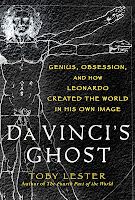Toby Lester, you crazy mixed-up history geek, what were you thinking, taking on Leonardo in a 200 page* book?
Interesting, yes. Did I learn new things? Yes. Has my image of da Vinci changed a little after reading? Yes, yes, yes. But come on; 200 pages? I felt like the story was just getting started.
The story arc, too, was a little herky-jerky. The big idea is that Leonardo was not the first, but the last (and greatest) in a long line of folks, who put Vitruvius's concept of a perfectly proportioned man fitted into both a circle and a square, in picture form. This is a big deal because Vitruvius's work was essentially forgotten for something like 1500 years, and it was only when men started to think about proportion, in art and architecture, in a serious way again during the Renaissance, did men rediscover Vitrivius again.
Only, there weren't that many people--well, maybe that's unfair--there weren't a ton of people that preceded da Vinci's Vitruvian Man, and really only a couple cited in the book that were actually trying to create an illustration of what Vitruvius said in his Roman Era book on architecture. The others were expressing ideas of perfect proportion as a representation of God's design of both man and the universe in his own image. Basically, the two ideas have very similar results, approached from slightly different directions.
Lester's thesis is sound, no complaints there. I may have just been caught up in some hype after hearing him discuss his book on the radio. I was expecting more and I'm a little disappointed that I didn't get it.
Da Vinci's Ghost is carefully researched and amply illustrated but may have been improved with a more linear timeline. Lester's writing is easy, and his enthusiasm is palpable throughout. He also showed me da Vinci as a man who (at least in his early career) was so distracted, that he almost seems to suffer from a kind of ADHD.** It's not an image I enjoyed, and I couldn't help wondering, if Lester had given himself another hundred pages or so, if this might have resolved itself more.
* This book is more like 275 pages, but there is, like, 70 pages of backmatter. Oh, and 15 pages of preface, and a dozen pages of prologue. Aaand, like 40 pages of epilogue. Okay, I'm done.
** After writing this, I did a search for ADHD for a link, and thought: what the heck, maybe he did have it and put that in the search. Sure enough, a variety of internetty sources (albeit, wishy-washy sources) also ask this same question.

No comments:
Post a Comment
Say it, I want to hear it...